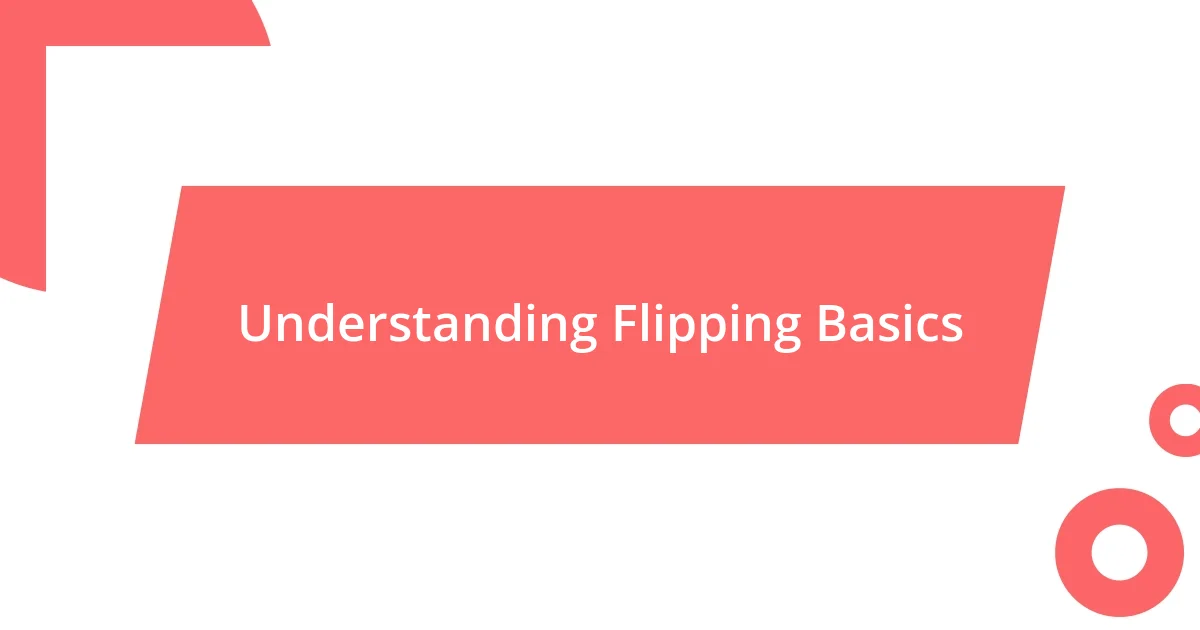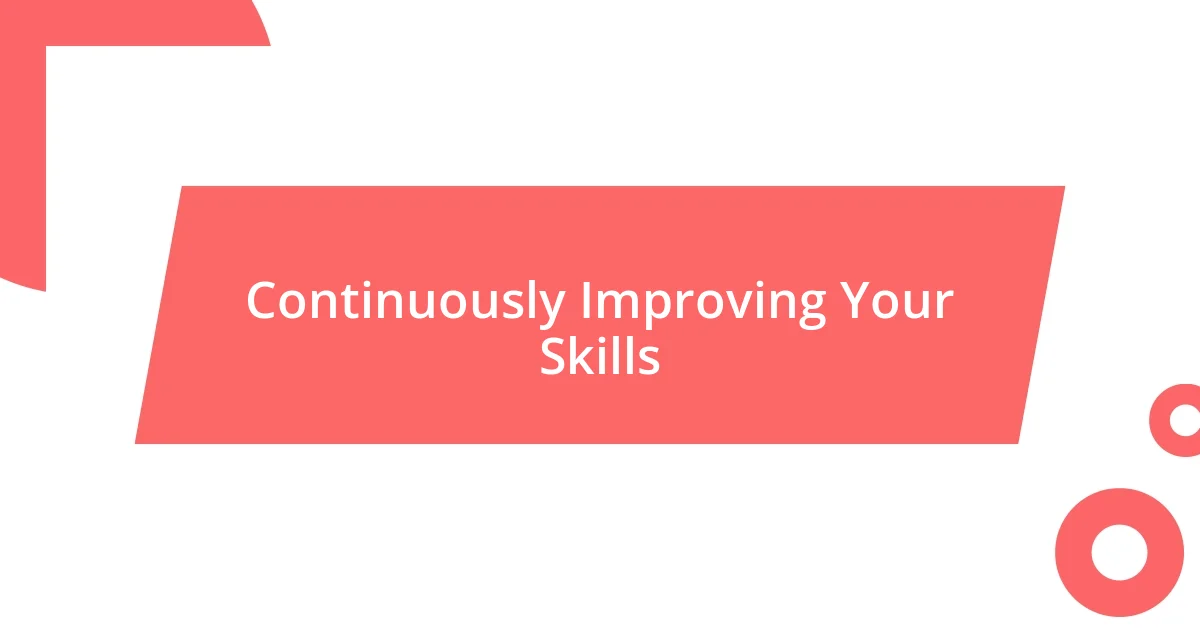Key takeaways:
- Embrace research and trends to identify desirable items, as understanding the community around collectibles can significantly impact success.
- Develop effective negotiation skills by building rapport and using knowledge of the market to persuade sellers; active listening is key.
- Continuously improve skills through goal-setting, community feedback, and embracing opportunities for learning, such as workshops.

Understanding Flipping Basics
Understanding the basics of flipping can feel overwhelming at first. I remember my initial attempts, where I spent hours poring over articles and feeling lost in a sea of jargon. Have you ever had that moment when you realize you’re diving into something much deeper than you anticipated?
At its core, flipping is about buying low and selling high, but it’s also about the thrill of the chase. I vividly recall my first flip—a vintage watch I snagged at a local flea market. It wasn’t just about profit; the excitement of finding a hidden treasure sparked a passion in me that I didn’t know existed. Embracing that passion transformed my approach; I wasn’t just tweaking items for resale, I was uncovering stories and potential.
This journey taught me the importance of research. I often ask myself, “What makes a piece desirable?” Analyzing market trends and knowing your audience can make all the difference. For instance, after realizing that retro gaming consoles were rising in value, I shifted my focus. It wasn’t just the item; it was understanding the community behind it that drove my success. How might your perception of flipping change if you embraced this perspective?

Finding Profitable Items
Finding profitable items is a skill that develops with experience and intuition. I remember stumbling upon a garage sale in my neighborhood, where I found a collection of vintage vinyl records. They were priced at mere dollars each, yet some were worth far more in the right market. It highlighted for me that sometimes, the best finds are hiding in plain sight, just waiting for someone who knows what to look for.
I often tell new flippers to keep a keen eye on emerging trends. Recently, I made a note of how home organization and minimalist living were gaining traction. I started scouring thrift stores for chic storage solutions; what I discovered were sought-after pieces that sold quickly. This experience reinforced the idea that understanding current demands can directly affect your ability to find hidden gems.
Trust your gut when assessing potential profitable items. I once hesitated over a peculiar-looking lamp at a flea market, but something about it felt unique, even if I couldn’t pinpoint why. After researching, I found it was part of a sought-after mid-century design. Sometimes, it pays off to take a risk on the unusual—it could lead to your next big win.
| Finding Items | Examples |
|---|---|
| Garage Sales | Vintage Records |
| Thrift Stores | Chic Storage Solutions |
| Flea Markets | Unique Lamps |

Mastering Market Research Techniques

Mastering Market Research Techniques
Understanding the nuances of market research can be transformative for any flipper. I remember sitting at my desk late one night, surrounded by notes and statistics, trying to make sense of the endless data available online. It was daunting at first, but embracing this time-consuming task opened up a new world of possibilities. The thrill of discovering that certain collectible action figures had become hot commodities made every minute worth it.
Effective market research boils down to knowing where to look and how to interpret the information. Here’s a handy list of techniques I rely on to boost my research game:
- Online Marketplaces: Platforms like eBay and Poshmark reveal what similar items are selling for.
- Social Media Trends: Following influencers and niche groups can provide insights into what’s currently desirable.
- Local Classifieds: Scanning your local Craigslist or Facebook Marketplace helps you gauge community interest and pricing.
- Selling Apps: Apps such as Mercari often highlight trending items that can guide your buying decisions.
- Industry Reports: Occasionally, digging into reports from collectors or niche publications helps forecast future trends.
Each of these techniques has helped me in my journey, and I often find myself reinvigorated by the knowledge gained. Remember that market research isn’t just about numbers; it’s about telling a story with data. That exhilarating feeling when I first realized I could connect the dots between what buyers wanted and my inventory is something every flipper should seek to experience.

Developing Effective Negotiation Skills
Developing effective negotiation skills is crucial in the flipping business. I recall a time when I was negotiating for a vintage furniture set at an estate sale. The seller initially quoted a steep price, but instead of diving straight into my counter-offer, I engaged in casual conversation about the piece’s history. This approach not only helped me build rapport but also allowed me to express genuine interest, ultimately leading to a price that left both of us satisfied. Isn’t it fascinating how a simple conversation can shift the dynamics of negotiation?
I’ve discovered that the art of negotiation often requires a mix of confidence and strategy. For instance, there was an occasion when I almost lost out on a collection of antique cameras. I firmly believed in their value, but the seller was set on a number. Instead of walking away, I confidently detailed the market demand and provided examples of recent sales. The seller sensed my passion and knowledge, which led to a successful compromise. Have you ever had to persuade someone with facts to seal a deal? It’s empowering when you realize that your expertise can work in your favor.
Practicing active listening has truly transformed my negotiation outcomes. I once attended a flea market and overheard a vendor lamenting about how some items didn’t sell well despite their quality. Instead of simply offering my price, I listened carefully and empathized with her frustration. By acknowledging her feelings and addressing her concerns, I not only secured a better deal but also turned the interaction into a pleasant exchange. Have you tried truly listening in negotiations? Sometimes, it’s the heart of the matter that can unlock the best deals.

Enhancing Your Selling Strategy
I’ve learned that enhancing my selling strategy often begins with understanding my audience better. There was a time when I struggled to sell a collection of vintage vinyl records. I realized I wasn’t connecting with buyers’ emotions; they weren’t just purchasing records, but memories and experiences. By sharing the stories behind each album during listings, I saw buyer engagement skyrocket. Have you ever thought about what your products mean to potential buyers? Sometimes, a story can create a connection that plain facts just can’t.
Another key aspect of my selling strategy is to create a sense of urgency. I remember listing a limited edition sneaker online and decided to run a 48-hour flash sale. The response was exhilarating! Not only did it lead to a quick sale, but the number of inquiries I received showed me that buyers often respond to a fear of missing out. Have you found ways to leverage urgency in your own sales? It’s a powerful tool that can turn a simple interest into a sale.
Lastly, I continually revise my selling platforms based on where my items perform best. I once listed a beautiful handmade necklace on several different sites simultaneously, only to realize that my best sales happened on Instagram. That platform allowed me to showcase the item through vibrant photos and personal touch, engaging directly with potential buyers through comments and stories. Have you assessed your platforms lately? Discovering where your audience thrives can significantly enhance your selling strategy.

Learning from Past Flips
Reflecting on my past flipping experiences has been an enlightening journey. I remember a particular flip involving a mid-century modern coffee table that seemed to hold little value at first glance. After purchasing it, I stumbled upon some online forums discussing the rising trend of mid-century designs. Realizing its potential, I polished it up, highlighted its unique features when reselling, and flipped it for a fantastic profit. It’s amazing how a bit of research can breathe new life into an undervalued piece, right?
Another important lesson emerged from a failed flip that still stings a little. I once bought a stack of old comic books, convinced they were a gold mine. Sadly, I didn’t thoroughly check for popularity or condition before the purchase. When I finally listed them, I barely received any interest. That experience taught me the value of doing my homework beforehand. I often think, how can I make sure I don’t repeat that mistake? It emphasizes the importance of understanding not just the item, but also the market.
I’ve also realized the significance of adapting based on past feedback. After selling a few items that received complaints about shipping delays, I implemented a more streamlined process. Now, I ship items promptly and communicate transparently with buyers. I can’t express how much this shift has improved my relationship with customers. Have you ever adjusted your methods based on past challenges? Each setback can truly become a stepping stone to greater success if we let it.

Continuously Improving Your Skills
One of the most rewarding aspects of flipping is the constant opportunity for growth. I remember attending a local workshop focused on sourcing techniques, and I left feeling invigorated. Learning from experienced flippers in a supportive environment opened my eyes to methods and resources I hadn’t considered before. Have you ever participated in a workshop that transformed the way you approach a hobby? Those shared experiences can really inspire new pathways in your flipping journey.
Additionally, I make it a point to set monthly goals for improving specific skills. For instance, I recently committed to enhancing my photography to attract more buyers. After a few dedicated practice sessions, I noticed my listings gained more attention just because of improved visuals. How often do you revisit your goals? Regular goal-setting helps me stay focused, evolving my skills consistently instead of waiting for random moments of inspiration.
Feedback from fellow flippers has also played a crucial role in my development. I joined an online community where we share tips and critiques of each other’s listings. I still remember the rush I felt when someone pointed out a minor detail I could enhance, which significantly improved my sales. How valuable do you think community feedback is? I’ve found that the diverse perspectives of others have illuminated blind spots I never noticed, allowing me to refine my approach and grow continually.















